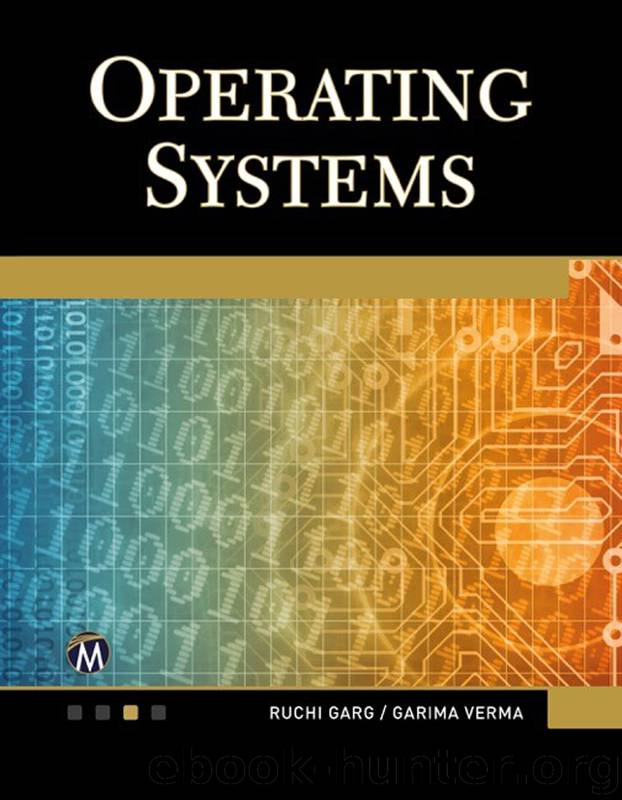Operating Systems: An Introduction by R. Garg & G. Verma

Author:R. Garg & G. Verma
Language: eng
Format: epub
Publisher: Mercury Learning and Information
Published: 2017-02-09T05:00:00+00:00
POINTS TO REMEMBER
A technique that allows the execution of processes that may not be completely in the main memory is called virtual memory.
To allow the programmer to make programs larger than the main memory size, the concept of virtual memory has been used.
Virtual memory is implemented by demand paging and demand segmentation.
In demand paging, the available memory space is divided into equal-size pages.
In demand segmentation memory is divided in various-sized segments.
The paging technique in which pages are loaded in the main memory according to demand or need is called demand paging.
When a desired page is not present in the main memory, then such a condition is known as a page fault.
For better performance of demand paging, the effective access time should be as small as possible.
The smaller the value of EAT, the better the performance of demand paging.
Selecting some page in memory that may not be in use and swapping it out creates a free frame in memory, and placing the desired page in that newly created free frame is called page replacement.
There are many page algorithms, for example, first in first out, optimal page replacement, and least recently used.
In the FIFO algorithm, swap out the page which was entered into memory first to create a free frame.
The FIFO algorithm suffers from Belady’s Anomaly.
According to Belady’s Anomaly, the total number of page faults may increase with an increase in number of free frames.
In optimal page replacement, remove the page that will not be used for the longest period of time.
In LRU replace the page which has not been used for a very long time.
In the second chance algorithm, the page which is present for the longest time in memory is the given the second chance to remain present in the main memory. When that page is encountered for a second time it is taken out to create room for the page that has caused the page fault.
The second chance algorithm is also known as the clock algorithm.
To allocate a minimum number of free frames to each process in the main memory because each process needs a minimum number of pages is known as the allocation of frames. When the processor spends more time in handling page faults rather than the actual processing of instructions present in the pages, then this situation is known as thrashing.
Download
This site does not store any files on its server. We only index and link to content provided by other sites. Please contact the content providers to delete copyright contents if any and email us, we'll remove relevant links or contents immediately.
Test-Driven iOS Development with Swift 4 by Dominik Hauser(10406)
Filmora Efficient Editing by Alexander Zacharias(6712)
The Infinite Retina by Robert Scoble Irena Cronin(6218)
Learn Wireshark - Fundamentals of Wireshark. by Lisa Bock(4483)
Linux Device Driver Development Cookbook by Rodolfo Giometti(4052)
Edit Like a Pro with iMovie by Regit(3918)
Linux Administration Best Practices by Scott Alan Miller(2963)
Linux Command Line and Shell Scripting Techniques by Vedran Dakic & Jasmin Redzepagic(2914)
Mastering PowerShell Scripting - Fourth Edition by Chris Dent(2874)
Creative Projects for Rust Programmers by Carlo Milanesi(2712)
MCSA Windows Server 2016 Study Guide: Exam 70-740 by William Panek(2603)
Docker on Windows by Stoneman Elton(2393)
Kali Linux - An Ethical Hacker's Cookbook: End-to-end penetration testing solutions by Sharma Himanshu(2373)
Hands-On AWS Penetration Testing with Kali Linux by Karl Gilbert(2215)
Hands-On Linux for Architects by Denis Salamanca(2151)
Programming in C (4th Edition) (Developer's Library) by Stephen G. Kochan(2130)
Computers For Seniors For Dummies by Nancy C. Muir(2127)
The Old New Thing by Raymond Chen(2079)
Linux Kernel Debugging by Kaiwan N Billimoria(1837)
